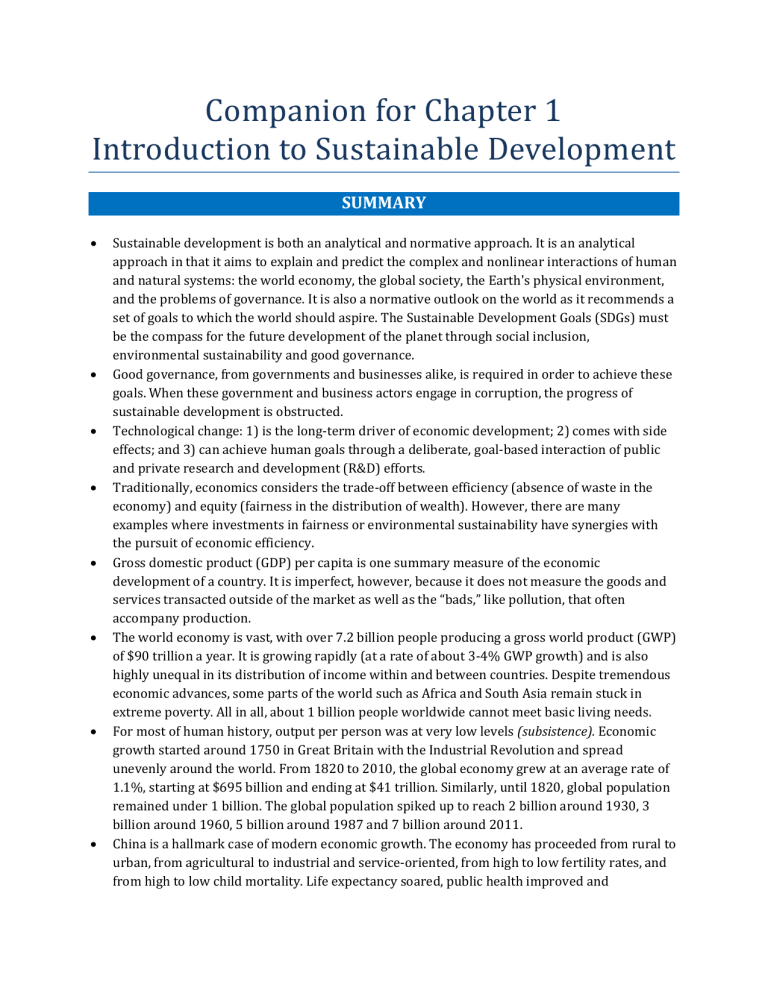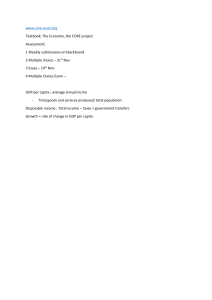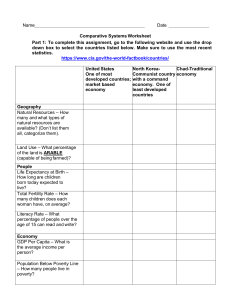
Companion for Chapter 1 Introduction to Sustainable Development SUMMARY Sustainable development is both an analytical and normative approach. It is an analytical approach in that it aims to explain and predict the complex and nonlinear interactions of human and natural systems: the world economy, the global society, the Earth's physical environment, and the problems of governance. It is also a normative outlook on the world as it recommends a set of goals to which the world should aspire. The Sustainable Development Goals (SDGs) must be the compass for the future development of the planet through social inclusion, environmental sustainability and good governance. Good governance, from governments and businesses alike, is required in order to achieve these goals. When these government and business actors engage in corruption, the progress of sustainable development is obstructed. Technological change: 1) is the long‐term driver of economic development; 2) comes with side effects; and 3) can achieve human goals through a deliberate, goal‐based interaction of public and private research and development (R&D) efforts. Traditionally, economics considers the trade‐off between efficiency (absence of waste in the economy) and equity (fairness in the distribution of wealth). However, there are many examples where investments in fairness or environmental sustainability have synergies with the pursuit of economic efficiency. Gross domestic product (GDP) per capita is one summary measure of the economic development of a country. It is imperfect, however, because it does not measure the goods and services transacted outside of the market as well as the “bads,” like pollution, that often accompany production. The world economy is vast, with over 7.2 billion people producing a gross world product (GWP) of $90 trillion a year. It is growing rapidly (at a rate of about 3‐4% GWP growth) and is also highly unequal in its distribution of income within and between countries. Despite tremendous economic advances, some parts of the world such as Africa and South Asia remain stuck in extreme poverty. All in all, about 1 billion people worldwide cannot meet basic living needs. For most of human history, output per person was at very low levels (subsistence). Economic growth started around 1750 in Great Britain with the Industrial Revolution and spread unevenly around the world. From 1820 to 2010, the global economy grew at an average rate of 1.1%, starting at $695 billion and ending at $41 trillion. Similarly, until 1820, global population remained under 1 billion. The global population spiked up to reach 2 billion around 1930, 3 billion around 1960, 5 billion around 1987 and 7 billion around 2011. China is a hallmark case of modern economic growth. The economy has proceeded from rural to urban, from agricultural to industrial and service‐oriented, from high to low fertility rates, and from high to low child mortality. Life expectancy soared, public health improved and educational attainment increased steeply. Nonetheless, inequalities between the urban and rural worlds and incomes have soared, and the economic take‐off has been accompanied by massive pollution of the physical environment. The world’s unprecedented large‐scale economic activity is creating an immense environmental crisis: humanity is changing the Earth's climate, the availability of fresh water, the oceans' chemistry, and the habitats of other species. The frequency and severity of environmental threats (e.g. water and weather‐related disasters, spread of diseases and pests, etc.) have risen dramatically, and it will continue to affect both the rich and poor. We have entered the era of the Anthropocene, an era in which humanity is creating major disruptions of the Earth's physical and biological systems. The extent of the damage could be so large that some scientists argue humanity might be leaving the "safe operating conditions" for the planet. Elaborating on these conditions, scientists have defined the "planetary boundaries," which are limits beyond which humanity should not venture. The business as usual (BAU) path is a scenario in which humanity continues on the current course. An alternative path, one that aims for social inclusion and environmental sustainability, will be called the sustainable development (SD) path. This dramatic change of course for humanity would require meeting human needs without destroying the physical environment and quick adoption of technologies. Many of the needed technological alternatives are still expensive and some fear, as a result, that we can't afford the SD path, or that it would come at the cost of ending economic progress. To achieve a SD trajectory, every part of the world will have to be involved in problem solving and in determining new and creative ways to ensure inclusive and sustainable growth. MODELING COMPANION To delve further, read through modeling companion A. In that modeling companion, we cover the basics of national income accounting. In particular, we discuss in more detail what an economy is, methods to measure its size (such as gross domestic product), and how to define economic growth. We also discuss the rule of 70 and demonstrate its use in evaluating economic growth. REVIEW EASY Concepts and Definition Can you define or explain the significance of these concepts? Normative vs analytical Complex system The Limits to Growth Brundtland Commission Rio Earth Summit Gross domestic product (GDP) Purchasing power parity (PPP) 1) 2) 3) 4) 5) Growth The rule of 70 Anthropocene Planetary boundaries Business as usual path Sustainable development path Sustainable Development Goals Check your facts What is the approximate change in life expectancy from the 1950s to today? In what year will the world likely reach the 8th billionth person? How many people are living in extreme poverty (measured by the World Bank at less than $1.25 a day)? What is the global economic productivity of the planet? Where and when did the Industrial Revolution begin? Answers: 1) about 25 years, 2) 2024/2025, 3) about 1‐in‐7, 4)around $80‐$90 trillion; 5) England, 18th century Review questions How do we measure the size of an economy? What are the hallmarks of economic development? What methods or standards are used to measure poverty? Why is extreme poverty a multidimensional concept? How is rural poverty different from urban poverty? According to the rule of 70, about how long would it take for an economy growing at 5% to double? What is so extraordinary about China's economic development? How did Deng Xiaoping reform China? When did this happen? How do environmental disasters impact society? What are some possible pitfalls in using a GDP indicator as a measure of the economy? Why can poverty be difficult to measure? DATA ACTIVITIES EASY A. Under‐5 Mortality Rate and the WDI database Go to the World Development Indicators database (http://data.worldbank.org/indicator) and make a graph for the under‐5 mortality rate. Add “high income,” “middle income,” and “low income” country groups to the graph. 1) Approximately how much higher/lower was the under‐5 mortality rate in low income countries compared to high income countries in 2013? 2) What was the percentage change of under‐5 mortality rates in low income countries between 2005 and 2012? Answer: 1) Roughly 12‐13 times higher 2) Approximate decline of 30% EASY B. Life Expectancy and Gapminder Graph life expectancy (y‐axis) versus time (x‐axis) in Gapminder: http://www.gapminder.org/world. Select Sweden, India, Haiti, and Mozambique. Beginning at 1800, press “Play,” and trace out the change in life expectancy over the last two centuries. Make sure to select “trails” in order to draw the time series. Compare Sweden and Mozambique. 1) What is the current life expectancy in Mozambique? 2) In what year was Sweden's life expectancy last at Mozambique's current level? Answer: 1)50 years 2) 1918 EASY C. GDP growth and the rule of 70 Go back to the World Development Indicators (WDI) database (http://data.worldbank.org/indicator), and find the 2012 GDP growth rates for India, Sweden, and Malawi. What is the approximate doubling time of each of those economies if the growth rate does not change over that time? Answer: 22,70,37 MEDIUM MEDIUM D. Income per capita and Gapminder Go to www.gapminder.com. Graph “Total population” on the y‐axis versus “Income per person” (GDP/capita, PPP$ inflation‐adjusted) on the x‐axis. 1) Try using a log scale for both axes. What changes? Do you think the graph is more or less readable when using a log scale? Explain why. 2) What does PPP mean and why is it a useful measure? 3) Describe and comment on the evolution of population and income per capita in the following periods: - From 1800 to 1850 - From 1850 to 1900 - From 1900 to 1960 - From 1960 to 2000 - From 2000 to 2013 E. Income per capita and the WDI database Go to the WDI database, http://data.worldbank.org/indicator, and download data in Excel format for “GDP per capita, PPP (current international $).” Plot GDP per capita versus time (from 1960 to 2013) for the following countries: United States, China, Rwanda and Singapore. Answer true or false for the following questions. If false, provide one sentence or a data point to justify. 1) The United States experienced strong growth throughout the second half of the 20th century, and this has contributed to their widening gap with lower income countries. 2) China experienced stronger growth in GDP per capita before 2000 than after 2000. 3) By 2013, both Singapore and China closed the income gap with the United States. 4) This graph supports the idea that divergence has occurred for the past 60 years. MEDIUM MEDIUM F. Population and GDP growth Using the World Bank database (http://data.worldbank.org/), download “Population (Total)” and “GDP (current US $)” for 5 countries of your choice. 1) Calculate and plot annual population growth rates and annual GDP growth rates for the three countries on the same graph. 2) Calculate and plot decadal (i.e. 1980‐1989, 1990‐1999, 2000‐2009 etc.) population growth rates and GDP growth rates for the three countries on the same graph. (Hint: To calculate 1 , where r is the average decadal growth decadal growth rate, you need to apply rate. Simply taking the average of annual growth rate will not get you the correct answer.) G. Timeline Using materials from the Age of Sustainable Development textbook as well as outside documentation, construct a timeline of the use and meaning of “sustainable development.” Make sure to provide appropriate quotes and references. DISCUSS AND DEBATE 1) Providing precise examples, discuss whether there is an obvious relationship between economic growth and sustainable development. 2) "The essence of sustainable development in practice is scientifically and morally based problem solving." (Chapter 4, p.43) Reflect on this definition of sustainable development. 3) Why and how is technological change related to sustainable development? Is this good or bad? Provide precise examples. 4) Discuss the potential trade‐offs and synergies that might exist in achieving sustainable development. 5) Discuss the role of good governance in achieving the Sustainable Development Goals. In particular, what might be some barriers in achieving good governance? 6) Using the case study below, discuss how sustainable development can be "measured." Discuss why it is important to develop indicators of sustainable development. Case Study The UNECE/Eurostat/OECD Task Force for Measuring Sustainable Development The UNECE/Eurostat/OECD Task Force for Measuring Sustainable Development In 2009, the Conference of European Statisticians set up a joint UNECE/Eurostat/OECD Task Force for Measuring Sustainable Development (TFSD). A key goal of the TFSD was to develop a broad conceptual framework that could bring together the wide variety of methods that have been used by both national and international institutions to measure sustainable development. The TFSD brings the concepts of well‐being and sustainable development together. Like the seminal UN‐ sponsored Brundtland Report, the TFSD regards sustainable development as being about distributive justice: meeting “the needs of the present without compromising the ability of future generations to meet their own needs” (World Commission on Environment and Development, 1987). Well‐being is then incorporated into the framework as a way to specify the “needs” of generations in a tangible and quantifiable way. The framework proposed by the TFSD is designed to be a flexible tool that can be adapted to fit the needs of individual countries. It includes twenty sustainable development “themes” that cover environmental, social and economic aspects of development. These themes are also mapped to three different conceptual dimensions, looking at human well‐being “here and now”; the potential for human well‐being among future generations “later”; and well‐being “elsewhere”, which refers to the ways in which the development paths of different countries impact on one another. The TFSD also put forward three different potential sets of sustainable development indicators, each covering a mix of these three different perspectives on well‐being. Sustaining well‐being over time is most clearly related to the Task Force recommendations that address the needs of generations “later”. To explore this particular dimension, the TFSD recommends a “capital approach” – i.e. a focus on the capital assets that should be preserved for future generations. These are grouped into four categories: economic, natural, human and social capital. Source: OECD How's life? 2013 report, Box 6.1. http://www.oecd.org/statistics/how‐s‐life‐23089679.htm FURTHER READING History of the phrase "sustainable development" The text which introduced the phrase "sustainable development". International Union for Conservation of Nature. 1980. World Conservation Strategy: Living Resource Conservation for Sustainable Development. Gland, Switzerland: IUCN. The report of the United Nations Commission on Environment and Development (a.k.a. Brundtland report) which popularized the phrase "sustainable development". Brundtland, Gro Harlem, and World Commission on Environment and Development. 1987. Our Common Future: Report of the World Commission on Environment and Development. Oxford: Oxford University. The first mention of sustainable development as a holistic approach between economic development, social inclusion and environmental sustainability. World Summit on Sustainable Development. 2002. Plan of Implementation of the World Summit on Sustainable Development. http://www.un.org/esa/sustdev/documents/WSSD_POI_PD/English /WSSD_PlanImpl.pdf. Nobel laureate Robert Solow grapples with the definition of sustainability and argues that we fail to weight enough the future generations in our present decisions. Solow, R. M. (1991). Sustainability: an economist's perspective. Solow, R. (2012). A few comments on ‘Sustainability and the measurement of wealth’. Environment and Development Economics, 17(03), 354‐355. Sustainable Development Goals initiative UN document calling for "Sustainable Development Goals". United Nations, Outcome document of the Rio+20 Conference. (2012). The Future We Want. 'I Our Common Vision'. UN report laying out the ten priority challenges of sustainable development. United Nations Sustainable Development Solutions Network. (2013). SDSN report: An Action Agenda for Sustainable Development. Economic history Economic historian Angus Maddison estimated the GDP per person over the long time period from the start of the Common Era (1 C.E.) and provided very detailed data for after 1820. This is the most extensive effort to document historical economic indicators. Maddison, Angus. 2006. The World Economy. Paris: Organization for Economic Co‐operation and Development. Planetary boundaries Blockbuster book published by the Club of Rome that argues forcefully that continued economic growth on the prevailing economic patterns would collide with the Earth's finite resources. Meadows, D. H., Meadows, D. L., Randers, J., & Behrens, W. W. (1972). The limits to growth. New York, 102. Seminal article in which scientists offer a visualization of planetary boundaries and argue that humanity is leaving the "safe operating conditions" for the planet. Rockström, Johan, Will Steffen, Kevin Noone, Asa Persson, F. Stuart Chapin, Eric F. Lambin, Timothy M. Lenton et al. 2009. “A Safe Operating Space for Humanity.” Nature 461(24): 472–475. Article reviewing the historical genesis of the phrase "Anthropocene" and suggesting that two dates (1610 and 1964) appear to conform to the criteria to mark the beginning of the Anthropocene. Lewis, S. L., & Maslin, M. A. (2015). Defining the anthropocene. Nature, 519 (7542), 171‐180.



